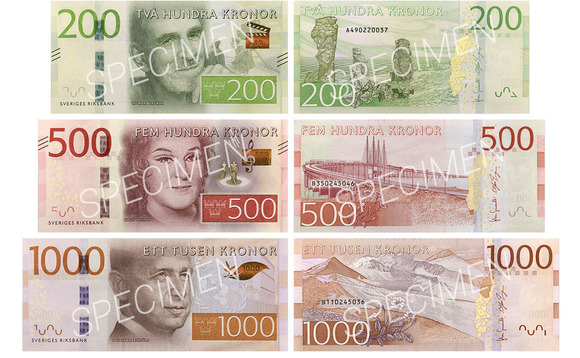
Banknote and currency services provider of the year: Crane Currency
Leading provider of micro-optics delivers full service from design to printing

The production of banknotes is not just the work of those with technological expertise – it is the work of craftsmen. With their universal dependability largely taken for granted, banknotes today are the culmination of several different technical components, combined into secure layers to form a design that is required to stay ahead of counterfeiters and engage the public, all at a reduced cost.
This year, US-headquartered Crane Currency has emerged as the provider of choice. With a heritage dating back to the late eighteenth century, Crane has established itself as a leader in micro-optic security threads, which harness hundreds of thousands of micro-lenses to animate each banknote, providing the public with a highly engaging and secure means of authenticating currency.
From concept to print
Crane offers a full range of services – everything from banknote design and security features to paper manufacturing and printing. Currently, 52 central banks use Crane's numerous services.
In 2016, the first of Sveriges Riksbank's new banknote series was launched. Designed by Göran Österlund, they recognise the contributions of one of Sweden's most prominent and cultural figures of the twentieth century.
 Redesigned notes at the Swedish central bank
Redesigned notes at the Swedish central bank
"The design was important, but primarily we wanted to upgrade security. And, as a result, the new series includes a range of new security features," says Mårten Gomer, technical manager for banknotes and coins at Sweden's central bank.
Following a competitive procurement process, Crane was selected by the Riksbank to transfer the artistic starting point into functional banknotes, with the process led by the design services department at Crane.
"We are trained to create banknotes that are engaging and appealing to the eye, but banknotes are much more than aesthetics and beautiful engraving," says Karin Mörck-Hamilton, Crane's head of design services.
"They have to be easily recognisable, create a sense of security for the user, be identifiable for a number of different machines, and they should not lend themselves to counterfeiting."
Gomer says the primary reason the Swedish central bank chose Crane as its supplier was that it "best met our requirements for quality, security and price".
"As the security features must be visible for the public, they are also visible for counterfeiters," says Gomer. "We needed to use techniques and security features that were simple to understand, but difficult to counterfeit."
Crane's security thread provided the perfect solution. Crane's micro-optic features are produced by equipment that it claims does not exist elsewhere. The secret, purpose-built processes produce billions of lenses a minute, with each lens shaped specifically to focus on an even smaller, customised icon below it. The result is an optical system that offers a distinctive image animation and fluid movement.
As the security features must be visible for the public, they are also visible for counterfeiters. We needed to use techniques and security features that were simple to understand, but difficult to counterfeit
Mårten Gomer, Sweden central bank
"Avant-garde" features
Crane currently has three products: Motion, Motion Switch and Rapid. "Crane Currency is an avant-garde supplier that has developed security features with outstanding movement effects and high counterfeit resilience," says Alejandro Alegre, general director of currency issuance at the Bank of Mexico, whose relationship with Crane spans more than three decades.
The images on Motion move in counterintuitive directions when the banknote is tilted, making it ideal for quick verification and public engagement. Motion Switch is an evolution of Motion, using two images that change from one to the other and back again.
The Riksbank opted for the Motion product for its new series. The feature is also used on Mexican peso notes and the US $100 bill. Rapid, launched in 2014, uses smaller, encapsulated lenses, making it especially well suited for high-volume transaction notes. The images are highly customisable, move more quickly and require less tilting.
"We have seen Rapid adopted at a very fast rate," says Tod Niedeck, corporate marketing director at Crane, with denominations in Lebanon, Ukraine, Nigeria, Vietnam and Bahrain using the feature, and Norway set to use it next year.
Alegre agrees with Gomer at the Riksbank that Crane's security features pass the litmus test of being simple to recognise but also hard to forge: "The effects in the features from Crane are easy to identify by the public and, at the same time, very difficult to counterfeit. That is the reason we have the Motion windowed thread in the current series."
Close collaboration
Producing modern banknotes requires both expertise and technical equipment of the highest level – and close collaboration to meet fixed deadlines is also important. This collaborative process enabled the Riksbank's Gomer and his colleagues to have numerous contacts with Crane's design and quality departments, its printing works and its technical department.
"A lot of details had to fall into place – everything from security components, such as where the Motion threads should be positioned, to quality issues surrounding which paper we should select," says Gomer, adding that the Riksbank also set requirements for durability and security to ensure there was no compromise, even when the banknotes become worn.
"The design team from Crane Currency has been highly sensitive to our wishes in this respect, as well as pedagogical in explaining different details and what works best."
A total of six new banknote designs were launched in Sweden through 2016.
Crane was also praised for its teamwork and collaboration by the Central Bank of Lebanon, which features Motion on its 100,000, 50,000 and 20,000 Lebanese pound notes. In 2015, Crane was awarded the printing order of the LBP1,000 note, this time with the Rapid thread.
"The tender was won by Crane and it included an enhancement of the existing thread from a colour shift to a lens based one as well as production of origination materials and printing," says cash operations executive director Mazen Hamdan.
The Lebanese central bank worked closely on a daily basis with Crane in the final days of the project to test banknote durability. During this time, Crane provided an international team of experts at all levels to move the project forward.
"The performance of Crane currency throughout the project was exemplary, namely its behaviour towards different market players, including other currency providers, to ensure the success of our project," says Hamdan.
The performance of Crane currency throughout the project was exemplary, namely its behaviour towards different market players, including other currency providers, to ensure the success of our project
Mazen Hamdan, Central Bank of Lebanon
Time is of the essence
Crane's knowledge and control over the whole banknote process came to the fore during a time-sensitive assignment for the Central Bank of Egypt.
In March, the central bank made the decision to relaunch its E£1 denomination banknote form because of change shortage for one-pound coins. The bank noted it had seen an increase in use of smaller denominations of tender from the general public, emphasising the need to increase supply.
"Nothing was ready," says the subgovernor of banknote printing, Khaled Farouq. "They had to start completely from scratch."
Crane was given just six weeks to turn the E£1 from coin to note, and the design team set about integrating its Rapid thread into a new format.
"We knew we had a tight deadline, and the task seemed almost impossible – but our teams never gave up. And in the end, we provided them with a solution we could be proud of," says Niedeck.
Working around the clock, Crane managed to create a solution that used robust security features in time for Ramadan.
"They understood our situation, and responded quickly," Farouq says.
"Admittedly, they had to sacrifice some design elements in order to meet the schedule – but given they had little to no time to prepare, we couldn't have asked for anything more."
Only users who have a paid subscription or are part of a corporate subscription are able to print or copy content.
To access these options, along with all other subscription benefits, please contact info@centralbanking.com or view our subscription options here: subscriptions.centralbanking.com/subscribe
You are currently unable to print this content. Please contact info@centralbanking.com to find out more.
You are currently unable to copy this content. Please contact info@centralbanking.com to find out more.
Copyright Infopro Digital Limited. All rights reserved.
As outlined in our terms and conditions, https://www.infopro-digital.com/terms-and-conditions/subscriptions/ (point 2.4), printing is limited to a single copy.
If you would like to purchase additional rights please email info@centralbanking.com test test test
Copyright Infopro Digital Limited. All rights reserved.
You may share this content using our article tools. As outlined in our terms and conditions, https://www.infopro-digital.com/terms-and-conditions/subscriptions/ (clause 2.4), an Authorised User may only make one copy of the materials for their own personal use. You must also comply with the restrictions in clause 2.5.
If you would like to purchase additional rights please email info@centralbanking.com test test test





